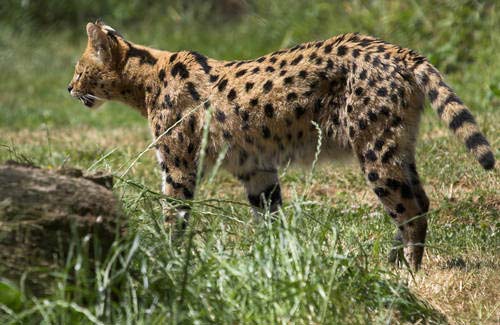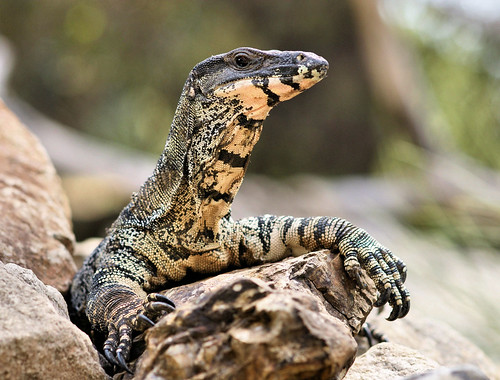Post by Deleted on Oct 17, 2013 21:24:23 GMT 5
Ocelot-Leopardus pardalis
The ocelot (pronounced /??s?l?t/; Leopardus pardalis), also known as the dwarf leopard, is a wild cat distributed extensively over South America, Central America, and Mexico. They have been reported as far north as Texas, and as far east as Trinidad and Barbados in the Caribbean. North of Mexico, they are found regularly only in the extreme southern part of Texas, although there are rare sightings in southern Arizona. The ocelot ranges from 68 to 100 centimetres (27 to 39 in) in length, plus 26 to 45 centimeters (10 to 18 in) in tail length, and typically weighs 8 to 18 kilograms (18 to 40 lb), although much larger individuals have occasionally been recorded, making it the largest of the generally dainty Leopardus wild cat genus. It has sleek, smooth fur, rounded ears and relatively large front paws. While similar in appearance to the oncilla and margay, which inhabit the same region, the ocelot is larger.

Serval-Leptailurus serval
The serval, Leptailurus serval or Caracal serval, known in Afrikaans as Tierboskat, "tiger-forest-cat", is a medium-sized African wild cat. DNA studies have shown that the serval is closely related to the African golden cat and the caracal. The serval is a medium sized cat, measuring 59 to 92 centimetres (23 to 36 in) in head-body length, with a relatively short, 20 to 38 centimetres (7.9 to 15 in) tail, and a shoulder height of about 54 to 66 centimetres (21 to 26 in). Weight ranges from about 7 to 12 kilograms (15 to 26 lb) in females, and from 9 to 18 kilograms (20 to 40 lb) in males. It is a strong yet slender animal, with long legs and a fairly short tail. The head is small in relation to the body, and the tall, oval ears are set close together. The pattern of the fur is variable. Usually, the serval is boldly spotted black on tawny, with 2 or 4 stripes from the top of the head down the neck and back, transitioning into spots. The "servaline" form has much smaller, freckled spots, and was once thought to be separate species. The backs of the ears are black with a distinctive white bar. In addition, melanistic servals are quite common in some parts of the range, giving a similar appearance to the "black panther" (melanistic leopard). Servals are nocturnal, and so hunt mostly at night, unless disturbed by human activity or the presence of larger nocturnal predators. Although the serval is specialized for catching rodents, it is an opportunistic predator whose diet also includes birds, hares, hyraxes, reptiles, insects, fish, and frogs. The serval has been observed taking larger animals, such as deer, gazelle, and springbok, though over 90% of the serval's prey weighs less than 200 g (7 oz).

The ocelot (pronounced /??s?l?t/; Leopardus pardalis), also known as the dwarf leopard, is a wild cat distributed extensively over South America, Central America, and Mexico. They have been reported as far north as Texas, and as far east as Trinidad and Barbados in the Caribbean. North of Mexico, they are found regularly only in the extreme southern part of Texas, although there are rare sightings in southern Arizona. The ocelot ranges from 68 to 100 centimetres (27 to 39 in) in length, plus 26 to 45 centimeters (10 to 18 in) in tail length, and typically weighs 8 to 18 kilograms (18 to 40 lb), although much larger individuals have occasionally been recorded, making it the largest of the generally dainty Leopardus wild cat genus. It has sleek, smooth fur, rounded ears and relatively large front paws. While similar in appearance to the oncilla and margay, which inhabit the same region, the ocelot is larger.

Serval-Leptailurus serval
The serval, Leptailurus serval or Caracal serval, known in Afrikaans as Tierboskat, "tiger-forest-cat", is a medium-sized African wild cat. DNA studies have shown that the serval is closely related to the African golden cat and the caracal. The serval is a medium sized cat, measuring 59 to 92 centimetres (23 to 36 in) in head-body length, with a relatively short, 20 to 38 centimetres (7.9 to 15 in) tail, and a shoulder height of about 54 to 66 centimetres (21 to 26 in). Weight ranges from about 7 to 12 kilograms (15 to 26 lb) in females, and from 9 to 18 kilograms (20 to 40 lb) in males. It is a strong yet slender animal, with long legs and a fairly short tail. The head is small in relation to the body, and the tall, oval ears are set close together. The pattern of the fur is variable. Usually, the serval is boldly spotted black on tawny, with 2 or 4 stripes from the top of the head down the neck and back, transitioning into spots. The "servaline" form has much smaller, freckled spots, and was once thought to be separate species. The backs of the ears are black with a distinctive white bar. In addition, melanistic servals are quite common in some parts of the range, giving a similar appearance to the "black panther" (melanistic leopard). Servals are nocturnal, and so hunt mostly at night, unless disturbed by human activity or the presence of larger nocturnal predators. Although the serval is specialized for catching rodents, it is an opportunistic predator whose diet also includes birds, hares, hyraxes, reptiles, insects, fish, and frogs. The serval has been observed taking larger animals, such as deer, gazelle, and springbok, though over 90% of the serval's prey weighs less than 200 g (7 oz).









